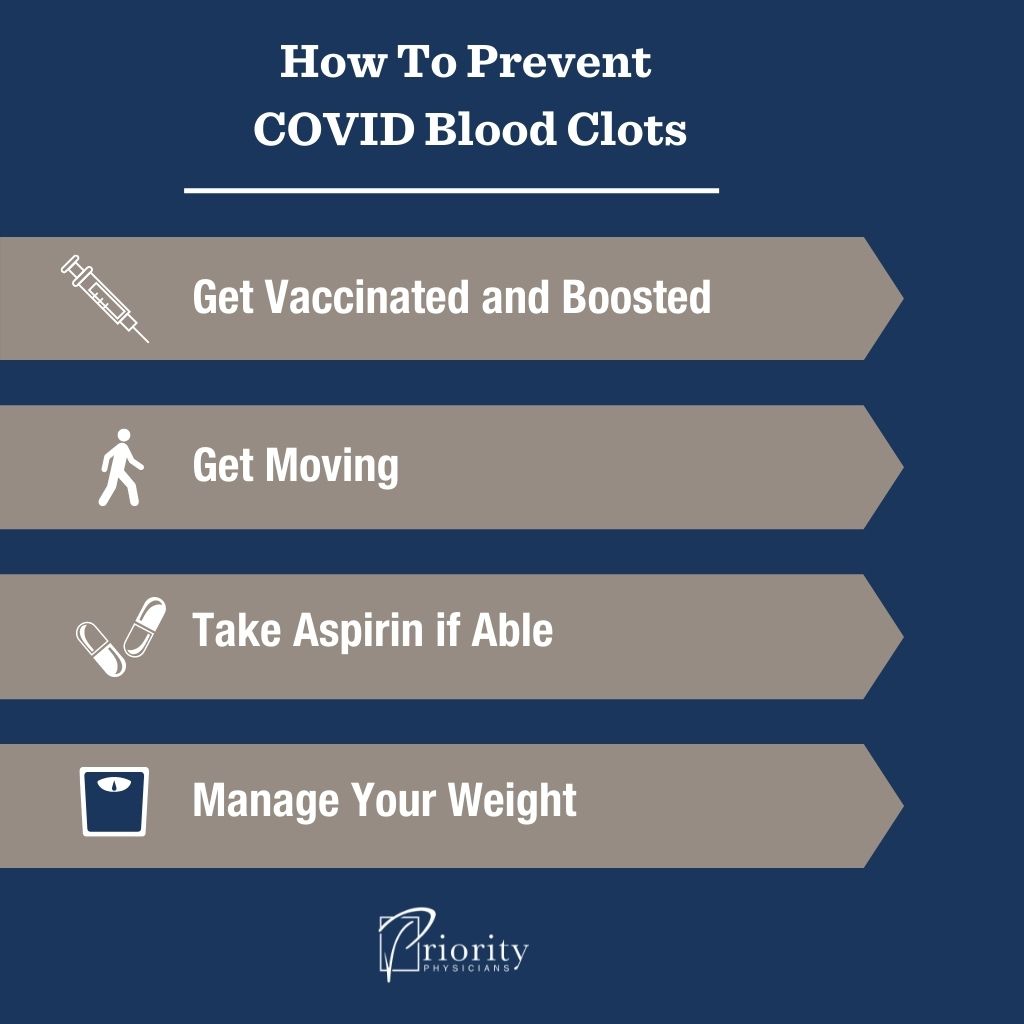When COVID hit in 2020, there was a lot we didn’t know about the virus and its effects on the human body. One of the biggest things we couldn’t figure out was why, after seemingly turning a corner and being discharged from the hospital, people were dying.
Why was this happening?
We now know that COVID increases clotting in the blood. But COVID blood clots don’t look or act like typical blood clots, so they went undetected for some time.
Fortunately, today we know much more about COVID blood clots and how to prevent and detect them.
What Are COVID Blood Clots?
Blood clotting can be extremely dangerous. You may have heard of deep vein thrombosis (DVT), which is when a blood clot develops in a deep vein of the leg. DVTs typically cause swelling in the affected leg, heat, pain, and/or discoloration.
Sometimes, part of a DVT can break loose from the main clot and end up in the lungs. This is called a pulmonary embolism (PE), and it can be deadly. PEs typically cause sudden shortness of breath and chest pain that worsens with breathing. Both DVTs and PEs require immediate medical attention.
These are the blood clots we’re familiar with and know how to screen for, locate, and treat.
COVID blood clots were another story.
How Are COVID Blood Clots Different?
COVID Blood Clots Are Micro Clots
COVID blood clots went undetected for so long because they were so different from the blood clots we knew.
DVT and PE blood clots are relatively large and easy to detect with imaging tests like CT scans and leg ultrasounds. COVID blood clots are much smaller micro clots and are much harder to detect with standard screening. Doctors were looking for larger clots in bigger veins; they didn’t know to search for tiny clots in smaller veins.
Tiny COVID blood clots also present differently from typical blood clots. For example, rather than obstructing a large artery in the lungs and causing sudden distress, COVID blood clots tend to block smaller vessels and cause gradual, subtle symptoms until the situation becomes severe.
Micro Clots Can Affect Other Parts of the Body
Because they’re so small, micro clots can lodge in unexpected parts of the body, like the fingers and toes. They can also affect other parts of the body, such as the gut and other internal organs. This can cause complications that might go unnoticed or undiagnosed at first.
Complications of COVID Blood Clots
The most common place we see severe complications from COVID micro clots is in the lungs.
In healthy lungs, the oxygen you breathe in transfers through membranes into the blood, and your blood’s waste carbon dioxide transfers to your lungs for you to breathe out. Oxygen then circulates throughout the body in the bloodstream, keeping all the parts of your body oxygenated and functioning.
Though a larger clot in the lungs brings on immediate symptoms and danger, micro clots in the lungs’ tiny vessels interfere with oxygen exchange more and more over time. They don’t stop you from breathing in and out, but the clots prevent your blood from picking up the oxygen you breathe in. So, though you’re breathing, your body is slowly suffocating.
Symptoms of COVID Blood Clots
The symptoms of COVID blood clots are harder to detect than those of DVTs and PEs. Because you can still inhale and exhale normally, you might not notice any symptoms at first. Or, you might develop shortness of breath, chest tightness or pressure, or difficulty breathing.
The danger is not as immediate with micro clots as with traditional blood clots, but it’s important not to let your condition become more serious. If you experience any of these signs or symptoms, contact your doctor.
How To Screen for COVID Blood Clots
The best way to screen for COVID blood clots at home is to use a pulse oximeter. They are inexpensive and easy to use. If you have COVID or are worried about COVID blood clots, monitor your blood oxygenation twice a day. If your level falls below 92, contact your healthcare provider. Early intervention is key in preventing more serious disease.
If you’re screened for COVID blood clots in a medical setting, you will likely have a D-dimer blood test. The D-dimer measures the level of a protein fragment in your blood to see whether you have a blood clot. Now that we know about micro clots, we can use the D-dimer and pulse oximeter together to discover and treat them before they cause more damage.
How To Prevent COVID Blood Clots
Get Vaccinated and Boosted
The best defense against the most harmful effects of COVID, including COVID blood clots, is to get vaccinated, and then boosted. Keep in mind that COVID vaccines don’t necessarily prevent you from getting COVID; their job is to prevent you from being hospitalized or dying.
Get Moving
Another way to prevent COVID blood clots — and all blood clots — is to get moving. When we feel sick, we just want to lie around until we feel better, and moving doesn’t sound appealing. But by movement, we don’t mean going for a jog.
Movement can mean going to the kitchen once an hour for a glass of water. Even stretching and flexing the muscles in your legs and feet can keep your blood moving enough to be beneficial.
Take Aspirin
If you’re concerned about COVID blood clots, talk to your doctor about beginning an aspirin regimen. Aspirin can help reduce the risk of clot-related complications by preventing clots from forming. However, don’t take aspirin without first speaking to your doctor about kidney and GI tract risks.
Manage Your Weight
Excess weight increases the chances of developing blood clots in general, but having excess weight AND having COVID increases that risk even more.
There’s no disadvantage to losing a little weight for the average American. If you aren’t sure what a healthy weight is for you, talk with your doctor.

Protect Yourself From COVID Blood Clots
COVID blood clots may be small, but they can cause serious damage. If you currently have or recently had COVID, an inexpensive pulse oximeter can help you monitor your risk, but you can also request a D-dimer from your doctor.
The best strategy is to avoid getting COVID blood clots altogether by doing everything you can to lower your risk. Get the COVID vaccine, get boosted, get moving, take aspirin if you’re able, and manage your weight to keep yourself as healthy as possible in a reality where COVID-19 remains.

